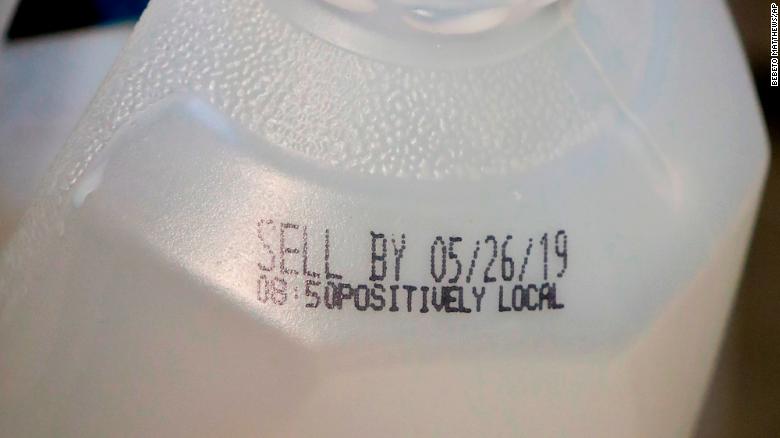We are throwing more and more food in the trash.
It's a reality 1:30
(CNN Business) --
When you walk into a supermarket and buy an item, from milk to cereal to a can of beans, you'll likely see a small date on the package preceded by "enjoy by," "sell by," or a similar phrase.
You might think that date is the absolute last day that food is safe to eat.
You would be wrong.
But you wouldn't be alone in jumping to that wrong conclusion, because the system behind food label dates is an utter mess.
There is no national standard for how those dates should be determined or how they should be described.
Instead, there is a patchwork system: a hodgepodge of state laws, best practices, and general guidelines.
"It's totally wild west," said Dana Gunders, executive director of ReFed, a nonprofit that tries to end food waste.
And yet, "a lot of consumers actually believe that they're being told to throw away food, or that even when they don't make that decision, they're breaking some rule," she said.
For food manufacturers, expiration dates actually have more to do with brand protection than safety concerns, explained Andy Harig, vice president of sustainability, tax and trade at FMI, a food industry association.
advertising
The expiration date is the company's estimate of when a food will taste best, its best date.
"You want people to eat and enjoy the product when it's at its peak, because that will increase their enjoyment, [and] encourage them to buy it again," he explained.
Confused about what expiration dates on food labels mean?
You're not alone.
The main consequence of this unclear labeling?
Food waste.
lots.
"Consumer uncertainty about the meaning of dates...is thought to contribute to about 20 percent of household food waste," the Food and Drug Administration wrote in a 2019 publication.
Wasted food often ends up in landfills, making it one of the biggest contributors to climate change.
According to some estimates, food loss and waste account for 8% of global greenhouse gas emissions.
Wasting food also means wasting money, something many consumers cannot afford, especially now that food prices are skyrocketing.
And food that is thrown away is diverted from food banks, where it is desperately needed.
They propose fines of up to US$64,000 to curb food waste in Spain
Make sense of dates
Although many companies put dates on their products, infant formula is the only food that is required to have expiration dates in the United States, said Meredith Carothers, a food safety expert with the USDA's Food Safety and Inspection Service.
Companies choose dates based on when they think an item tastes best.
But FSIS has its own safety recommendations.
Many canned goods can last on shelves between one and five years, according to the agency, if stored properly.
Under the right conditions, packets of dried rice and pasta can last about two years.
The FDA offers tips and guidelines for food storage on its website.
But the rules are very different for many perishables.
While consuming non-perishable items past an expiration date is probably fine, fresh meat and poultry could spoil even before the expiration date on the label.
That's because store refrigerators tend to be colder than home refrigerators, Carothers explained.
Once consumers take meat and poultry home, they must follow home storage rules, he said.
FSIS instructs people to cook or freeze some meats within two days of bringing them home from the store.
how did we get here
Manufacturers began printing expiration information on products in the early 20th century.
At first, the date was written in code: retail employees had to match each code to a date using a key, but the codes were incomprehensible to customers.
In the 1970s, grocery shoppers were crying out for more information about the quality of food on supermarket shelves.
Under pressure from activists, including the distribution of pamphlets deciphering expiration codes, food manufacturers began putting dates on their labels.
At first, this "open dating" tactic seemed to be working.
In February 1973, The New York Times published an article titled "Food Dating Finds Please Customers, Reduce Loss."
The article pointed to a study by the USDA and the Consumer Research Institute, a group backed by food manufacturers, that concluded open dates had cut the number of consumer complaints about buying stale or spoiled food in half. .
Food manufacturers began sharing expiration dates with consumers about 50 years ago.
But by the end of the decade, those examining the system were less convinced of its merits.
A 1979 study by the now-defunct Office of Technology Assessment noted that open expiration dates may not have been the right way to calm consumer fears.
"There is little evidence to support or deny the claim that there is a direct relationship between the open shelf-life date and the actual freshness of food," the study found.
There is no way to “precisely determine dates for various products, no consensus on what kind of date or dates… to use for what product, or even what products to date, and no real guidelines on how to display the date”, the report's authors wrote.
Decades later, we are still in the same boat.
"There are no uniform or universally accepted descriptions used on food labels for open expiration dates in the United States," according to current USDA guidance.
The FDA said that manufacturers may not place false or misleading information on labels, but that "they are not required to obtain agency approval of quality-based voluntary date labels they use or specify how they arrived at the date on that were applied".
FSIS's Carothers reiterated that dates can be applied as long as they do not mislead customers and comply with service labeling standards.
The smell test?
To prevent food waste, some advocates encourage people to trust their senses when determining whether certain foods are safe to eat.
British retailer Morrisons said earlier this year that it will remove "sell by" dates from some of its milk brands, switching instead to "best before" dates and encouraging customers to decide whether to discard the product based on how it looks and smells.
Morrisons offered these guidelines to consumers: If it looks curdled or smells sour, throw it out.
If it looks and smells good, you can consume it even after the date.
Morrisons said this year that it will remove expiration dates on its branded milks in some markets.
"When food spoils beyond the point where we'd like to eat it, our defenses work really well," ReFed's Gunders said.
"If the food doesn't look good, if it doesn't smell good, if it doesn't taste good, if it's slimy...then absolutely, we shouldn't eat that food."
In general, Gunders recommended that those who are concerned about food safety be strict about consuming foods before the expiration date if they have a "higher potential for carrying listeria."
A way to identify those items?
They're the foods pregnant women are told to stay away from, she said.
Another way to avoid confusion, experts say, is to regulate the language used to describe these dates.
"Best By" vs. "Use By"
The Food Date Labeling Act of 2021, introduced in December of last year, wants manufacturers to use "use by" or "best if used by" only before dates on labels.
The bill is the latest in a series of legislative efforts to make a national labeling standard.
Here's the logic: Companies that decide to put a date on labels need to make it clear to consumers if the item is potentially unsafe after that date or if it just tastes a bit off-putting.
If it's a security issue, they have to use "use before".
When it comes to food quality, "best if used before" is the way to go.
Gunders and agencies such as the FDA and USDA point to this harmonization of labels as a good solution.
Many companies have already made the transition.
Del Monte, which sells canned fruits and vegetables among other products, uses "best if used by."
In an email, the company explained that the dates "are indicative."
Dole, which has dates on its packaged salads, also uses the "best if used by" label.
Even if the bill becomes law and all businesses make the same changes, one piece of the puzzle will still be missing: alerting consumers to the change and what it means.
After all, consumers who pick up an item today won't necessarily know that "use by" is different from "best if used by", or if either is different from something like "enjoy by" or "sell by". prior to".
To make the dates clearer to the public, there needs to be a "constant and committed effort to help consumers think about this," the IMF's Harig said.
"I think it's going to take some work to figure it out."
Labelled




/cloudfront-eu-central-1.images.arcpublishing.com/prisa/2YU22TQLBFE6RNDZLB44QR47GU.jpg)




